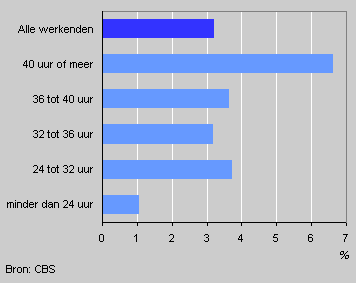Teleworkers are highly educated and have long work weeks

Teleworkers are for the most part highly educated and usually have work weeks exceeding 40 hours. They usually work at higher management level and in the sector business services. Over 3 percent of the active labour force are teleworkers.
Long work weeks
Teleworking is most common among persons working 40 hours a week or more. Within this category 7 percent are teleworkers, whereas the rate among people working less than 24 hours a week is only 1 percent. The benefits of teleworking are reduced commuter times, less traffic congestion, reduced CO2 emission, a more flexible working scheme and a quieter workplace.
Percentage of teleworkers by number of hours worked
Type of work and education level of teleworkers
Highly educated people more often use computers at work than lower educated people; indeed 8 percent of teleworkers are highly educated, as against only 1 percent of the lower educated.
Percentage of teleworkers by level of education

In the private sector computer service centres employ 54 percent of teleworkers. In the sector other business services 11 percent of employees are teleworkers. In the sector hotels and restaurants, on the other hand, teleworkers are very rare (1 percent). Teleworkers usually work in those areas of the private sector where the use of computers and the Internet are most common. Teleworkers are frequently found at higher management level (11 percent).
Percentage of teleworkers by sector
Teleworkers more often men over 35
Most teleworkers are in the age category 35 and older, whereas only 1 percent of them are under the age of 25. Twice as many men as women are teleworkers.
Lydia Geijtenbeek